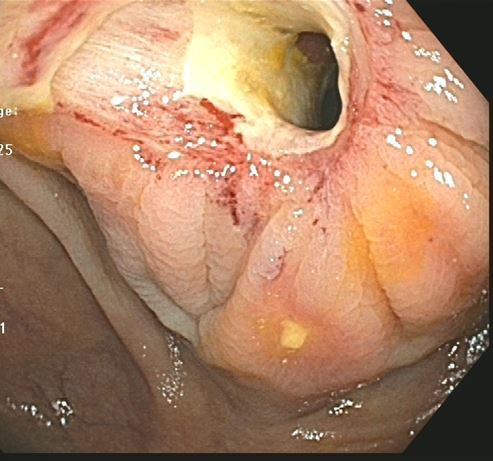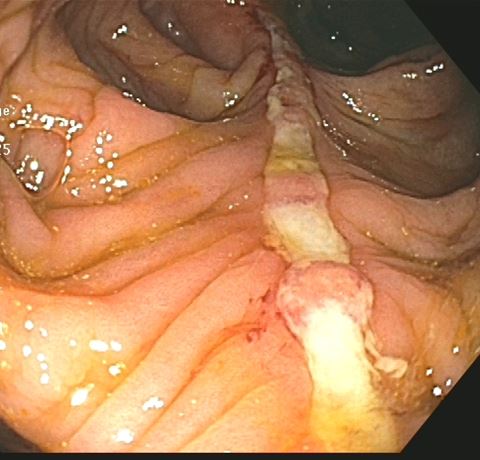Monday Poster Session
Category: Colon
P2506 - The Hidden Cost of Pain Relief: A Rare Case of Ulcerated Colonic Stenosis Secondary to Chronic NSAID Use

Rao Mustafa Afzal, MD
Hunt Regional Medical Center
Greenville, TX
Presenting Author(s)
1Hunt Regional Medical Center, Greenville, TX; 2Texas Oncology, Dallas, TX
Introduction:
NSAID-induced colonic strictures, also known as diaphragm disease of the colon, are a rare but important complication. These diaphragm-like fibrotic rings often affect the proximal colon and can mimic malignancy and IBD or present with features of bowel obstruction, anemia, and GI bleeding. We present a case of a patient with NSAID induced colonic stricture who presented with iron deficiency anemia.
Case Description/
Methods:
A 77-year-old male with a history of HTN and prostate cancer treated with radiation therapy presented with a 6month history of iron deficiency anemia. He noted melena and occasional bright red rectal bleeding, which he attributed to known external hemorrhoids. He had been taking diclofenac for several years. Laboratory studies revealed hemoglobin of 10.2 g/dL, serum iron 25 µg/dL, ferritin 10 ng/mL, TIBC 416ug/dL and iron saturation of 5%.
Upper endoscopy was unremarkable; however, colonoscopy revealed a non-traversable, ulcerated stenosis, 1 cm long with a 7 mm luminal diameter in the proximal ascending colon. There were multiple areas of severely ulcerated mucosa in the adjacent ascending and transverse colon. Biopsies revealed ulceration with, associated fibro- purulent exudate, and granulation tissue.
Given his history of IDA and concern for potential occult malignancy he underwent
right hemicolectomy. Pathology revealed ulcers in ileum ranging from 0.6cm to 2.0cm, and the ileocecal valve was nearly completely obscured by fibrosis.
Discussion:
Diaphragm like colonic strictures observed in our patient may represent a distinct mucosal response pattern, potentially triggered by prolonged exposure to higher doses of NSAIDs in specific GI segments. Alternatively, these strictures may reflect a chronic NSAID-induced mucosal injury. In our case, the latter appears more plausible.
One proposed mechanism involves NSAID-induced alterations in local eicosanoid metabolism, which may compromise mucosal barrier integrity and increase permeability to luminal toxins and antigens. Furthermore, NSAIDs have been demonstrated to impair neutrophil chemotaxis and function, thereby contributing to mucosal inflammation and ulceration. These changes can lead to stricture formation and may result in chronic gastrointestinal bleeding.
This case highlights a rare but important complication of long-term NSAID use and underscores the need for increased clinical vigilance when evaluating patients with unexplained GI symptoms.
Figure: shows colonic stricture
Figure: shows adjacent ulceration
Disclosures:
Rao Afzal indicated no relevant financial relationships.
Mohammed Y. Youssef indicated no relevant financial relationships.
Jaison John indicated no relevant financial relationships.
Stewart Whitney indicated no relevant financial relationships.
Rao Afzal, MD1, Mohammed Y. Youssef, MD1, Jaison John, MD1, Stewart Whitney, MD2. P2506 - The Hidden Cost of Pain Relief: A Rare Case of Ulcerated Colonic Stenosis Secondary to Chronic NSAID Use, ACG 2025 Annual Scientific Meeting Abstracts. Phoenix, AZ: American College of Gastroenterology.

